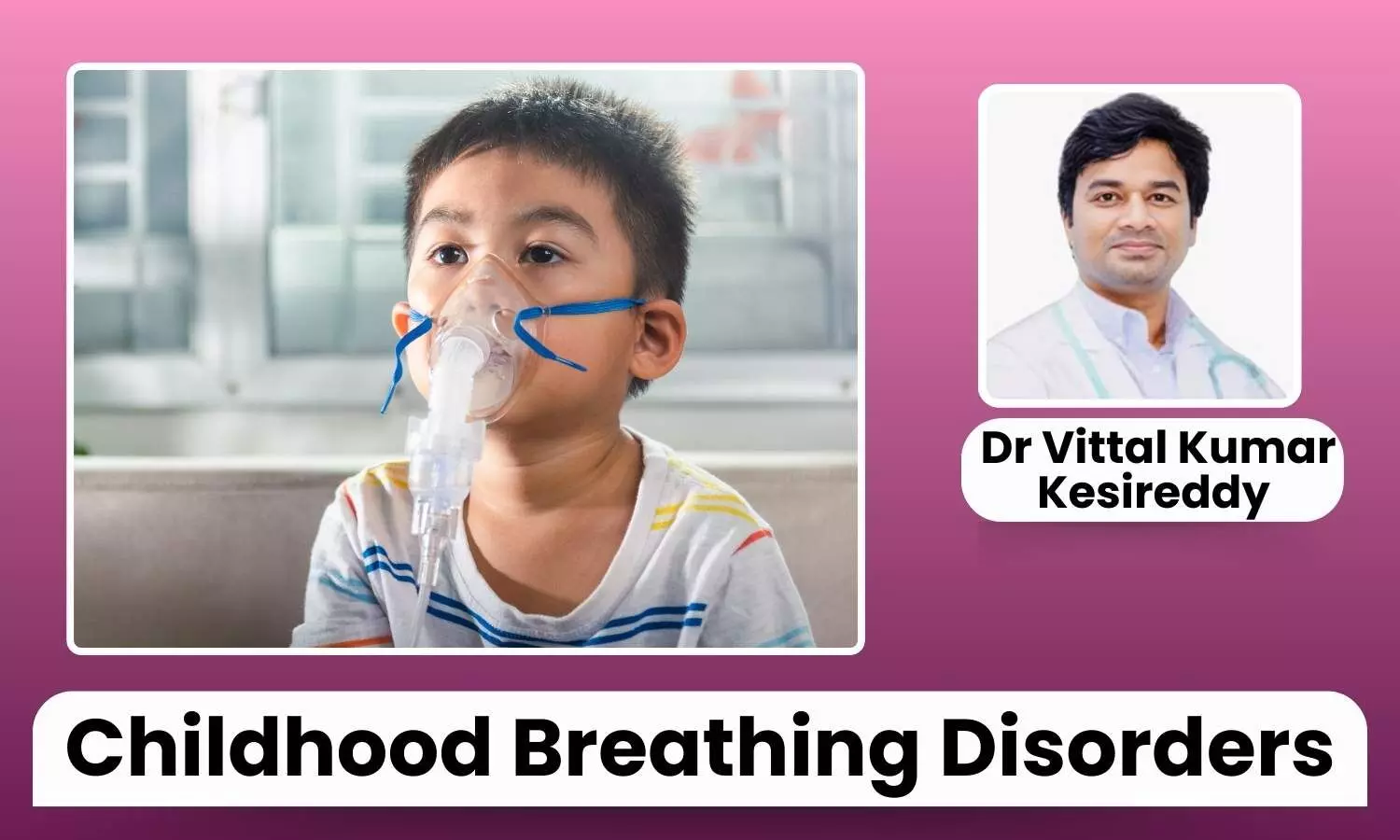Common Childhood Breathing Disorders and How Caregivers Can Cope - Dr Vittal Kumar Kesireddy

Breathing problems faced by children can be distressing, not only for the child but also for their families. Conditions such as childhood asthma, croup, bronchiolitis, pneumonia, and fever with chills are among the most common causes of pulmonary concerns for little ones.
While these issues may panic, comprehending their signs, origins, and management plans empowers guardians to offer timely and helpful care.
Childhood Asthma: A Persistent Plight
Asthma represents one of the most pervasive persisting afflictions in children. It is characterized by irritation and tightening of the airways, which can induce wheezing, coughing, chest constriction, and breathlessness.
What sparks asthma varies extensively and may include allergens like dust mites and pollen, infections of the respiratory system, cold weather, and physical activity.
Strategies for Control
Medication: Inhalers, specifically those containing corticosteroids, are fundamental for asthma management. Quick aids like bronchodilators assist during intense episodes.
Avoid Irritants: Identifying and decreasing contact with sparks is pivotal. For instance, utilizing air purifiers, laundering bedding regularly, and steering clear of tobacco smoke can significantly relieve signs.
Continuous Monitoring: Peak flow meters and asthma action plans can help parents and children track the condition and respond proactively to worsening symptoms.
Croup: Recognizing the "Barking Cough"
Croup is a viral affliction that impacts the upper airways, causing swelling surrounding the vocal cords. This ailment is most common in children under five years of age and is often distinguished by its distinctive barking cough, hoarseness, and stridor—a high-pitched sound heard during inhalation.
Strategies for Care
Home Remedies: Gentle cases of croup can often be managed at home. Providing humid air, like from a steaming bathroom or a cool-mist humidifier, can ease breathing.
Hydration: Ensuring the child stays hydrated helps thin mucus and reduce airway irritation.
Medical Intervention: In severe cases, corticosteroids or nebulized epinephrine may be administered to decrease airway swelling.
Bronchiolitis: A Concern for Babies
Bronchiolitis is a widespread respiratory illness in infants, typically caused by the respiratory syncytial virus (RSV). It leads to inflammation of the small airways in the lungs, causing signs like wheezing, coughing, and difficulty feeding.
Management Strategies
Most cases of bronchiolitis are mild and can be managed with supportive care alone, including adequate hydration and fever reduction if needed.
However, parents must carefully monitor signs of worsening such as rapid or heavy breathing, dehydration evident from lack of tears or dry mouth, or bluish-tinged skin resulting from lack of oxygen.
In severe cases, hospitalization may prove necessary to deliver supplemental oxygen through masks or mechanical ventilation involving intubation.
Pneumonia: A Deadly Respiratory Disease
Pneumonia can be a life-threatening infection that impacts the tiny air sacs in the lungs, called alveoli, causing them to swell with fluid or pus. It may be caused by bacteria, viruses, or fungi, but bacteria are the primary trigger in children.
Symptoms often include spiking fever, full-body chills, stabbing chest discomfort, swift breathing, and profound exhaustion. A telltale manifestation is a worsening, productive cough that expels mucus that can appear greenish or yellowish in hue.
Management Strategies
If pneumonia is suspected, timely diagnosis through chest X-ray imaging and lab work is absolutely crucial for treatment and recovery. A delay in proper diagnosis and management can seriously impact a child's health.
Antimicrobials and Medications are Key: Bacterial varieties necessitate antibiotics recommended by a paediatrician. Some viral strains may respond to antiviral drugs, such as those caused by influenza. The prescribed treatment plan must be closely followed to efficiently battle the infection.
Rest is Restorative: Allowing adequate relaxation and hydration supports the body's natural healing mechanisms. Though the urge to play may be strong, sticking to periods of quiet repose aids recovery.
Hospitalization for Complex Cases: Serious instances with issues like oxygen deficiency potential require inpatient attention with supplemental oxygen. Round-the-clock monitoring and intervention by medical experts gives patients the best chance at regaining wellness.
Fever and Chills Warrant Attention
In children, the combination of fever and whole-body shivering is often indicative of an underlying ailment, including respiratory infections. Left uncared for, such manifestations can evolve into severe conditions like sepsis.
Strategies for Care
Temperature Regulation: Follow a paediatrician's advice on using antipyretics like acetaminophen or ibuprofen to lower a fever.
Monitor Hydration: Be certain kids drink enough fluids to avoid dehydration from the fever.
Seek Help for Persistent Symptoms: Lingering high fever or chills may signal infections requiring additional testing and customized treatment plans formulated by a physician.
General Tips for Families
1. Stay informed by learning from your paediatrician about symptoms, potential exacerbating factors, and treatment options specific to the respiratory condition affecting your child.
2. Vaccination also remains important, particularly for influenza, as additional infections risk compounding breathing issues.
3. Encourage health through a balanced diet, activity, and rest to sustain natural immune defences.
4. Know When to Seek Help: Certain alarming signs require swift action—difficulty breathing, sustained high fever, lethargy, or bluish lips and skin.
The Role of Paediatric Care Partnership between families and healthcare providers is paramount. By communicating openly and acting promptly upon medical guidance, caregivers can establish stability at home.
Their attentive care and timely interventions when needed frequently transform crises into manageable cases. Remember, for any condition impacting a child’s respiratory health, parental vigilance paired with clinical oversight hold the power to alter severe to mild.


